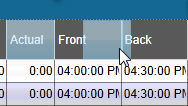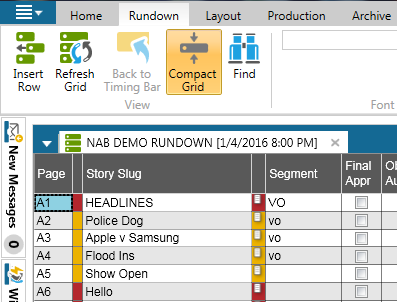Rundown Layout
Rundowns have a large number of columns that you can add, resize, and re-order. Users can use these columns to display the information that is relevant to their job role.
Basic Time Columns
The following table summarizes the timing columns available in Rundowns. See Add Columns for information about how to add columns to a Rundown.
By default, the ENPS Client calculates timing based on Actual Time. Your System Administrator can change this behavior, however, so that Rundowns will calculate the timing based on Estimated Time rather than Actual Time.
If there is no value for Actual Time, ENPS will use Estimated Time until an Actual Time is entered.
|
Estimated Duration |
A value entered manually, typically by the show's Producer. |
|
Text Time |
Automatically calculated based on the length of text in the Stories. If a Story has a manually entered Read Rate, the Text Time will reflect that value; otherwise it will reflect the global value set by your site's System Administrator. |
|
Media Time |
Reflects the media durations that were manually entered into Stories. Refer to Media Timing Fields for more information about timing media objects. |
|
Actual Time |
Reflects Text Time + Media Time according to the definitions listed above. By default, ENPS Rundowns calculate overall timing based on Actual Time although this setting will vary depending on how it has been configured by your site's System Administrator. Refer to Media Timing Fields for more information about timing with media. |
|
Back Time |
Calculates the length of time back from the end time of the Rundown, based on the length of individual items. |
|
Front Time |
Calculates time forward from the start time of the newscast based on the length of individual items. |
|
Cume Time |
Adds up the time of all items in a Rundown working forward. |
|
Back Cume Time |
Adds together the time of all items in a Rundown, working backward from the end time. |
|
Elapsed Time |
The amount of time that the timing bar, engaged when the show is on the air, spends on each row as it moves through the Rundown. |
Media Timing Fields
The following fields are used for timing media objects in the Rundown. When media is linked to an ENPS Story, a MOS Object message is added to the Story. It may include an Object Time, and it may also include an item's Editorial Time.
|
MOS Object Time |
Length of video or audio media objects stored on the Media Object Server. As the MOS sends updated duration times of individual objects to the ENPS Server, the time in this field will be updated. For example, as an editor changes the duration of a package from By default, this duration is not normally added to overall program time but this behavior can be changed by setting the Add MOS Durations option in the Rundown Properties. |
|
MOS Editorial Time |
A user-defined variable time also reported from the MOS Server set on either the vendor's software or in the ActiveX. MOS Editorial times are not added to the Media Time. If MOS Editorial Time is present, it will override the MOS Object Time in the calculation of Actual Time so that Actual Time = Text Time + MOS Editorial Time + Manually entered durations. This value depends on the Add MOS Durations setting in the Rundown Properties which controls whether the lengths of MOS objects will be added to the timing of the Rundown. If the setting is set to 0 then Actual Time is the Text Time plus any manually entered durations. If this value is set to 1 then Actual Time equals the Text Time plus the MOS Object Durations plus any manually entered durations. A global default for the Add MOS Durations setting is configured by your site's System Administrator. If a MOS Editorial Duration is present in the MOS Item Reference, then the ENPS Server uses the MOS Object Editorial Time instead of the Object Duration. |
|
MOS User Duration |
Manually input a length for MOS objects in the story. When you click on this column you will see a list of MOS item references in a Story. You can enter the number of seconds you want added into the Rundown timing. For example, if there is a voiceover and sound on tape, you might enter:
The overall timing is not affected by the duration of the voiceover, but it is affected by the time of the sound on tape. For MOS-enabled systems test off-line with your MOS device to ensure that it works as expected. According to the MOS protocol, the MOS device should ignore any tags it might not understand, but it is important to know your MOS device will do so before putting this into production. |
MOS Columns
The following table contains a list of MOS columns and their descriptions. See Add Columns for information about how to add columns to a Rundown.
A typical Rundown in a MOS environment might include the MOS Object Slug, MOS Status and MOS Object Time and/or MOS Editorial Time, depending on the configuration. The MOS columns that your site uses most should be included in a Rundown Template.
|
MOS Abstracts |
A short description of the media object, provided by the MOS device. |
|
MOS Channels |
By default, the channel assignment is left blank. Click on this column to assign it a specific value. You may want to place all MOS Video Clips into Stories with a default "blank" channel assignment so that the Video Server can automatically assign channels or the video editor may wish to assign channels manually. The ENPS Server does not provide any input validation or range checks on these values so it is possible for a user to enter a value that the Media Object Server does not understand. If you click in this column in a Story that contains at least one media item reference, pressing any key opens the channel dialog window and places the cursor in the channel assignment field for the first item reference. The Tab key can be used to move to additional item references in the same Story. Enter and Esc can be used to save or cancel your changes. |
|
MOS ID |
MOS device that owns the MOS Item Reference in the story. This is useful to include in Rundowns where multiple MOS devices are in use. |
|
MOS Item Slug |
Name of the MOS Object or Clip. A MOS item slug is created automatically when you drop a media object into a Story. The default name is the ENPS Story name with a number appended that indicates the sequence of the object within the Story. The number is added only to create a unique name. This number may not be a valid indicator of the position of the Item in the story. The most accurate indication of sequence is the order the object appears in the Rundown window. This column may contain entries to launch ActiveX controls, such as a CG modal control, without having to open each Story and click on the MOS Item reference. |
|
MOS Obj Slug |
Name of the media Object or Clip as named on the MOS-integrated production device. This name is generated on the device itself; you cannot change it from the ENPS Rundown. This column may contain entries to launch ActiveX controls, without having to open each Story and click on the MOS Item reference. |
|
MOS Status |
Status of the item as reported by the MOS-integrated production device. The device might send messages such as "Not Filed", "Ready", "Playing", "Stopped" and "Not Ready". Producers or editors can track the progress of production material and make decisions about Story output. This information is displayed only when the Rundown has the MOS Control Active option enabled on the Production tab of the Rundown Ribbon, and the MOS-integrated production device is sending messages to the ENPS Server. |
|
MOS Time |
Time when the media object was last updated on the MOS device. |
|
Object AutoCreate |
Object in a Story that allows media to be linked to that Story. You can set a property of a Story template so that when a Story created from that template is created in or moved to a MOS-active Rundown a media object will be created automatically on the target MOS device (if the device supports this feature). You may use this option to create individual MOS objects on the MOS server. |
|
Object Group |
Displays the name of the folder on the server where the media objects are saved. This is useful if you want to copy the clip to another location. |
|
Object Placeholder Create |
Object in a Story that allows media to be linked to that Story. When you click on this column you will get a table from which you may specify:
|
Once you add a MOS object to a Story in a Rundown, double-click in either of the MOS Object Slug or MOS Item Slug columns to view the MOS item directly from the Rundown. This is primarily for use with modal controls. For example, if a CG vendor provides a modal control, it would be possible to preview all CGs in a newscast with the Rundown full screen without having to open each Story and click on the MOS item reference. This feature is also enabled for special one line MOS object slug display columns typically used to display the slugs of summary MOS objects.
Add Columns
|
|
Users can customize the types of information they see when they use a Rundown by creating a Rundown layout and then saving that layout as their personal view. Click Select Columns on the Layout tab of the Rundown Ribbon to view a list of available columns. Many of these columns will be self-explanatory. |
Move Columns
|
|
To move a column to a new position, place the mouse pointer anywhere in the column's title box and drag the column to its new location. The column will appear to the left of where it was dropped. |
Resize Columns
|
|
To resize a column move the mouse pointer to the right border of the column's title box until it becomes a double-sided arrow. Hold down the left mouse button and drag the border to make it wider or narrower. Release the mouse button when the column is the desired width. |
Compact Grid
|
|
You can reduce the height of each row in your Rundown by selecting the Compact Grid button on the Rundown Ribbon. This maximizes the number of rows a user can see in a Rundown. |
Save Layout
You can save the current Rundown as your personal layout. If you have permissions, you can also save the rundown as a template or a stored layout. Both of these options are available on the Layout tab on the Rundown Ribbon.


